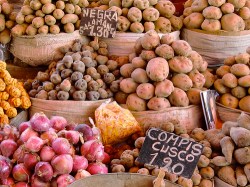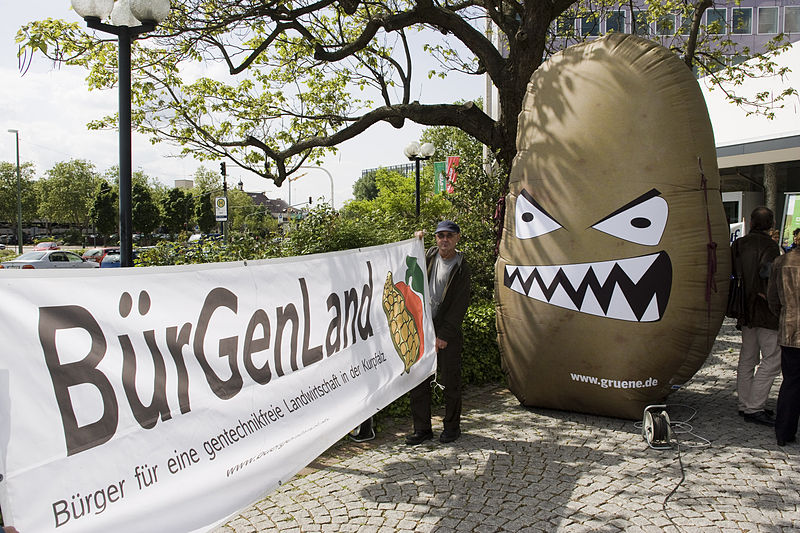
A protest against GMO potatoes. (Photo by BASFPlantScience.)
Last week’s announcement that Ireland’s environmental protection agency approved the nation’s first trial of the genetically modified potato has reactivated the conversation about the spuds, which have actually been kicking around Europe — on a trial basis — since 2010.
Potatoes are an industrial crop; we grow nearly as many of them worldwide as we do corn, soy, wheat, and sugar, and those industries all rely heavily on genetic engineering. And — like corn, sugar, and soy — potato starch is now often valued for its indirect uses, such as in animal feed and biofuel. So it’s not surprising that industry forces would be pushing for giant swaths of industrial-starch-producing GMO potatoes. But to do so in Ireland would involve a unique historical irony.
You see, it just so happens that the Irish potato famine of the 19th century is held up as one of the most striking examples of the way monocrops — those grown with little or no genetic diversity — are vulnerable to disease. Heralded as a miracle when it arrived from South America in the 1800s, the potato produced more calories per acre than wheat and corn, and virtually did away with the mass-scale hunger many European countries were facing at the time. (Some say it was the potato that made European nations into world superpowers, and its cultivation also marked the beginning of today’s industrial agriculture model.)
Because farmers were only growing very few potato varieties at a time, however, Europe — and in particular Ireland — was an easy target for disease. As historian Charles Mann wrote in 1493: Uncovering the New World Columbus Created, excerpted here in Smithsonian magazine:
In two months [a fungus called] P. infestans wiped out the equivalent of one-half to three-quarters of a million acres. The next year was worse, as was the year after that. The attack did not wind down until 1852. A million or more Irish people died — one of the deadliest famines in history, in the percentage of population lost. A similar famine in the United States today would kill almost 40 million people.
All this makes potatoes a powerful symbol of biodiversity (and lack thereof) in the global food system. But to read this week’s news, it’s easy to wonder if we’ll ever learn our lesson. According to a BBC report, the new GMO potato has been engineered to withstand blight, a dangerous potato disease that “can rapidly turn the vegetable into an inedible mush.” Through genetic splicing, scientists say the new potato now has a resistance gene taken from a wild South American potato.
John Spink, head of crop research at Teagasc, the Irish Agriculture and Food Development Authority that has applied for the license, told the BBC: “You could achieve the same results by conventional breeding, but it might take 15 to 20 years — this way we can do it in weeks.”

Potatoes in Peru. (Photo by Eric Miraglia.)
Meanwhile, South American nations have maintained an incredibly diverse array of potatoes. Mann writes that as recently as 1995:
… a Peruvian-American research team found that families in one mountain valley in central Peru grew an average of 10.6 traditional varieties — landraces, as they are called, each with its own name. In adjacent villages Karl Zimmerer, an environmental scientist now at Pennsylvania State University, visited fields with up to 20 landraces. The International Potato Center in Peru has preserved almost 5,000 varieties. The range of potatoes in a single Andean field, Zimmerer observed, “exceeds the diversity of nine-tenths of the potato crop of the entire United States.” As a result, the Andean potato is less a single identifiable species than a bubbling stew of related genetic entities.
It’s highly likely that in a field where you were growing 20 varieties of potato, at least a few of those would be resistant to whatever disease might come along. And I’m guessing that at least some of those 5,000 varieties already contain traits that are similar to the ones from the wild potato that have been genetically inserted in this GMO variety. And yes, a 15 to 20 year time investment in traditional breeding may sound onerous, when compared to the genetic quick fix. But all this makes me wonder: Is it ever worth making an end run around real biodiversity?
The four-year trial in Ireland is slated to be relatively small — two hectares or around five acres — but it will also probably take place in the open air, where cross-pollination with other potatoes is highly possible. In a related article in the Irish Independent, critics pointed to the fact that GMO crops have also been shown to impact other forms of life in the fields. It reads:
[R]esearch on GM crops in Britain had shown a worrying decline in farmland biodiversity, where numbers of bees and butterflies were found to be 68 [percent] lower in GM fields.
Indeed, that’s key to biodiversity — every species lives in relationship to those around it. Potatoes don’t grow in a vacuum; and surely the scientists involved know this. But it rarely benefits the companies engineering these products to factor in ecosystem health.
Stella Coffey, an activist who runs a blog called GM Moratorium, told the BBC: “It’s absolutely preposterous to use such a risky tech as your first line of action.” And she has a point. You don’t have to be convinced that GMOs are inherently unsafe in their own right, or that we should all start growing 20 varieties of potatoes in our backyard (although, if you’re a gardening nerd like me, that might sound pretty amazing), to see this tendency for the agriculture community to default to new technology — often simply because it’s there and it has the potential to generate revenue for shareholders — as more than a little disturbing. It may not be as risky as it was to feed the whole of nation on just a few varieties of potato in the 1850s, but how can we know that for sure?
Shhh. Did you hear that? I think the ancestors on my Irish side are rolling in their graves.
Correction: This story mistakenly referred to the Amflora potato as being involved in this trial. In actuality, Amflora’s trials began in Germany, Sweden and the Netherlands earlier this year.


